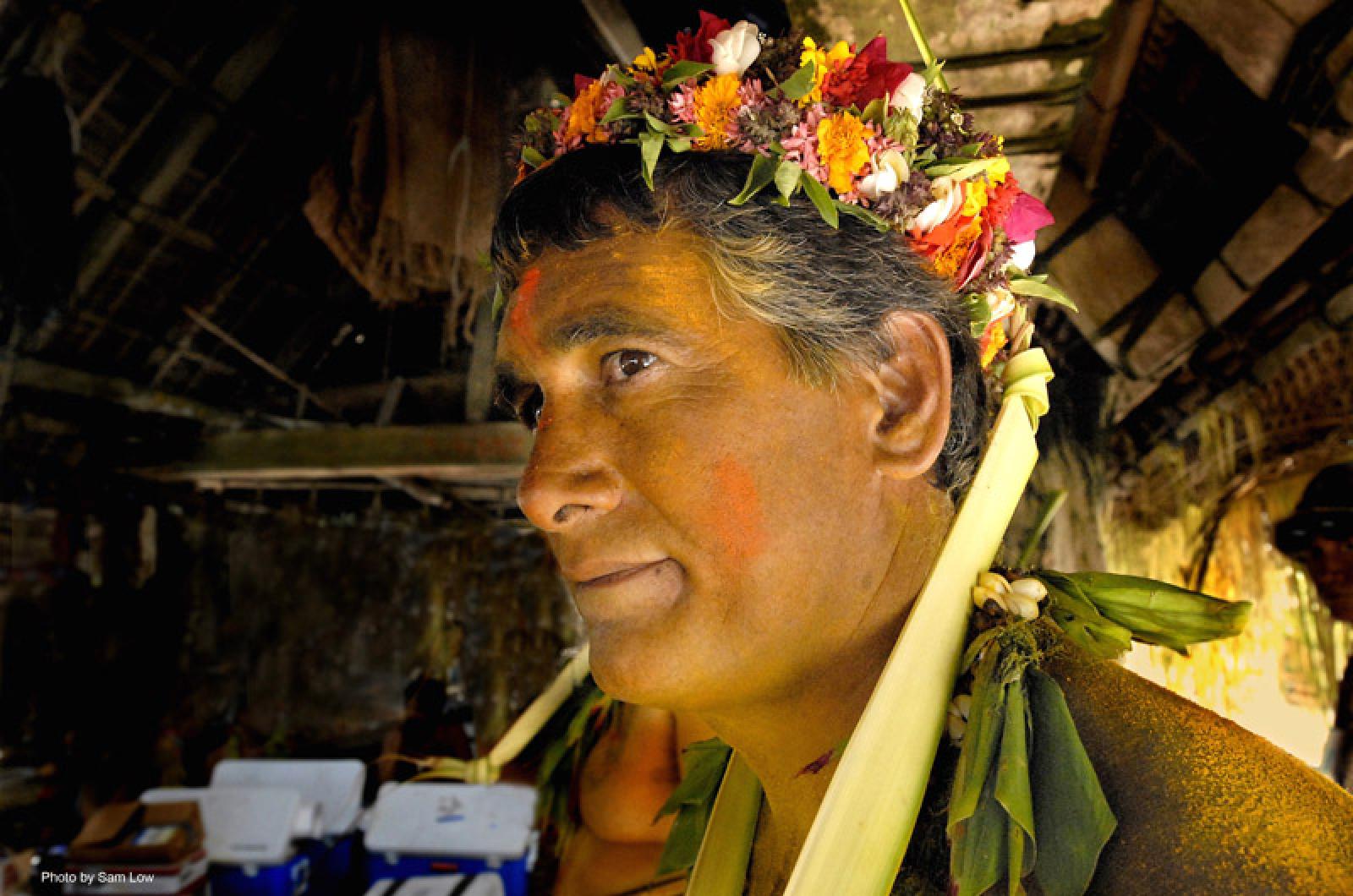When Hokule’a sails into Vineyard Haven on Tuesday, June 28 the captain and navigator Bruce Blankenfeld will guide her to Tisbury Wharf. Bruce stands over six feet tall and he weighs under 180 pounds. He is well built but not showy. Thick black hair caps a long handsome face. His eyes are set deep under full lids. His shoulders are large, his waist is slim and his forearms are those of an outrigger canoe paddler.
Bruce became involved with Hokule’a in 1977 by volunteering on training sails, along with working on construction and repair of the canoe in drydock. Since then, he has voyaged more then 70,000 miles throughout Polynesia and Micronesia and on voyages to Vancouver, Alaska and Japan. In 2007, in a sacred ceremony on the tiny Micronesian island of Satawal, he was initiated into the rank of pwo (master) navigator by Mau Piailug, the man who taught all of Hokule’a’s navigators the ancient art of navigating without instruments by following signs in nature.
“Bruce is the most natural ocean person I think I have ever met,” said Nainoa Thompson, navigator and president of the Polynesian Voyaging Society. “When he leaves the land and goes to sea there is no adjustment time. No nothing. Bruce changes from the land to the ocean by becoming completely relaxed. He calms people down because he’s so calm and relaxed himself. If you took the ocean away from Bruce, you would take away half his life. He is just so innately inclined to the ocean.”
When Bruce is on land, which is not often now that Hokule’a is sailing around the world on a voyage to malama honua (care for the planet), he is often found in his garden tending taro, a plant that was at the center of ancient Hawaiian farming and remains so today.
“For Bruce growing taro is in his genes,” said Nainoa. “Caring for the land nurtures his soul. Whenever he’s in his taro, I don’t bug him. I walk right on by. It’s his soul that is being nurtured along with the taro.”
“In the old days,” Bruce said, “Hawaiians all worked together on the taro patches. Of course the life style was totally different. It wasn’t based on economics, it was based on mutual understanding and working together. It was based on the Hawaiian concept of malama, caring for each other. Everybody got together, they worked on farming and they reaped the benefits from it. And everybody also had their own little plots, their own little farm. In the old days people worked together in the fish ponds, the taro fields and the sweet potato gardens for the basic sustenance of everyone.”
Hawaiians like Bruce have learned from their ancestors that all life is tied together in a seamless web, a concept that scientists today might refer to as ecology. The Hawaiian landscape inhabited by Hawaiians — which they called an ahupua’a — grades from mountaintop to ocean with each of the separate ecological zones providing food and all the basic resources to sustain life. Hawaiians of old believed the ocean and the sea were not separate; they were part of a much larger natural whole.
“Every plant and animal in the sea has a counterpart on land,” Bruce said. “A mana opelu is a kind of taro named after the opelu fish, the spots on the stock of the taro are the same as the spots on the belly of the opelu. The Kumu fish and the aholehole fish have their counterpart on land as taro and also as a pig. The pig was often used as an offering to the gods but when there was no pig available you could use either a kumu or an aholehole from the sea in the offering. Everything that you see on land is tied to something in the sea.”
The Hawaiian concept of malama which underlies the voyage of Hokule’a emerges from this basic idea of the unity of all life.
“When they used to go to the mountains and cut down trees for the canoes, our ancestors didn’t think that they were taking the tree’s life. There were ceremonies for cutting the trees and addressing the appropriate spirits. They were not taking the tree’s life, they were just altering its essence, taking it from the forest and putting it into the sea. And in Hawaii the sea and the land are tied together. The sea and the land rely on each other for life just like a woman and a man rely on each other to bring forth new life. You pollute your ocean and you hurt the land. You pollute your land and the ocean is going to feel it. Everything relies on each other for life. Animals, fish, birds deserve the respect that you treat all life with. That’s basic. Everything that is living deserves your respect. That’s why you don’t go cut down forests or pollute your environment, everybody and everything is related somehow.”
To learn more about Hokule’a and her voyage around the world, visit hokulea.com. Hokule’a will visit Martha’s Vineyard from June 28 to July 1 at Tisbury Wharf. Mr. Low is a former Hokule’a crewmember and the author of Hawaiki Rising – Hokule’a, Nainoa Thompson and the Hawaiian Renaissance. He lives in Oak Bluffs.







Comments (1)
Comments
Comment policy »